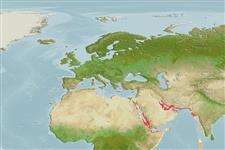>
Blenniiformes (Blennies) >
Tripterygiidae (Triplefin blennies) > Tripterygiinae
Etymology: Enneapterygius: Greek, ennea = nine times + Greek, pterygion = little fin (Ref. 45335).
Environment: milieu / climate zone / depth range / distribution range
นิเวศวิทยา
เกี่ยวกับทะเล,น้ำเค็ม สัตว์น้ำหน้าดิน; ระดับความลึก 2 - 12 m (Ref. 88983). Tropical
Western Indian Ocean: Red Sea.
ขนาด / น้ำหนัก / Age
Maturity: Lm ? range ? - ? cm
Max length : 2.1 cm SL เพศผู้/กระเทย; (Ref. 88983)
Short description
เครื่องมือที่ใช้ในการแยกชนิดสัตว์,สิ่งมีชีวิตออกจากกัน | สัณฐานวิทยา | ความยาวต่างๆ
เงี่ยงครีบหลัง (รวม) : 14 - 17; ก้านครีบอ่อนที่หาง (รวม) : 8 - 9; เงี่ยงครีบก้น: 1; ก้านครีบอ่อนที่ก้น: 15 - 17; สัตว์มีกระดูกสันหลัง: 32 - 33. Diagnosis: Dorsal fins III + XI-XIII + 8-9 (usually III + XI-XII +8- 9); anal fin I, 15-17 (usually 16); pectoral fin 15: 3+5+7. LL, pored scales8-12; notched scales 21-23, starting at 2 scale rows below the end of the pored series; total lateral scales 28-29; transverse scales 2/5; nape with scales, abdomen scaleless, single row of scales at base of pectoral fin. Body depth 4.5-5.2 in SL. Vertebrae 10 + 21-22. Dentary pores 3 + 2 + 3; head 3.1-3.4 in SL; eye 2.5-3.0 in head length; orbital cirrus minute, rounded flap about half the diameter of pupil, distally serrated margin; supratemporal sensory canal crescent-shaped; first dorsal fin same height in males and females, about 60% of the second. Key features are: body bars brown; caudal peduncle spots 2 black, the lower one smaller; five black blotches on anal fin, anteriormost largest and darkest; face pink with brown bar below eye; first dorsal fin crimson in males (Ref. 57774, 88983).
Adults inhabit bays and lagoons rich in corals, 2-12 m; usually found in crevices near Porites or on the vertical face of this coral (Ref. 88983). Eggs are hemispherical and covered with numerous sticky threads that anchor them in the algae on the nesting sites (Ref. 240). Larvae are planktonic which occur primarily in shallow, nearshore waters (Ref. 94114).
Life cycle and mating behavior
Maturities | การสืบพันธุ์ | Spawnings | Egg(s) | Fecundities | ตัวอ่อน
Holleman, W. and S.V. Bogorodsky, 2012. A review of the blennioid fish family Tripterygiidae (Perciformes) in the Red Sea, with description of Enneapterygius qirmiz, and reinstatement of Enneapterygius altipinnis Clark, 1980. Zootaxa 3152:36-60. (Ref. 88983)
IUCN Red List Status (Ref. 130435)
Threat to humans
Harmless
Human uses
เครื่องมือ
Special reports
Download XML
แหล่งที่มาจากอินเตอร์เน็ต
Estimates based on models
Preferred temperature (Ref.
123201): 24.8 - 29.3, mean 28.2 °C (based on 202 cells).
Phylogenetic diversity index (Ref.
82804): PD
50 = 0.5000 [Uniqueness, from 0.5 = low to 2.0 = high].
Bayesian length-weight: a=0.00794 (0.00346 - 0.01822), b=3.08 (2.88 - 3.28), in cm total length, based on LWR estimates for this (Sub)family-body shape (Ref.
93245).
ระดับชั้นอาหาร (Ref.
69278): 3.0 ±0.3 se; based on size and trophs of closest relatives
ความสามารถในการกลับคืนสู่ปกติ (Ref.
120179): ความสูง, เวลาต่ำสุดที่จะทำให้ประชากรเพิ่มขึ้นเป็น 2 เท่าใช้เวลาน้อยกว่า 15 เดือน (Preliminary K or Fecundity.).
Fishing Vulnerability (Ref.
59153): Low vulnerability (10 of 100).
